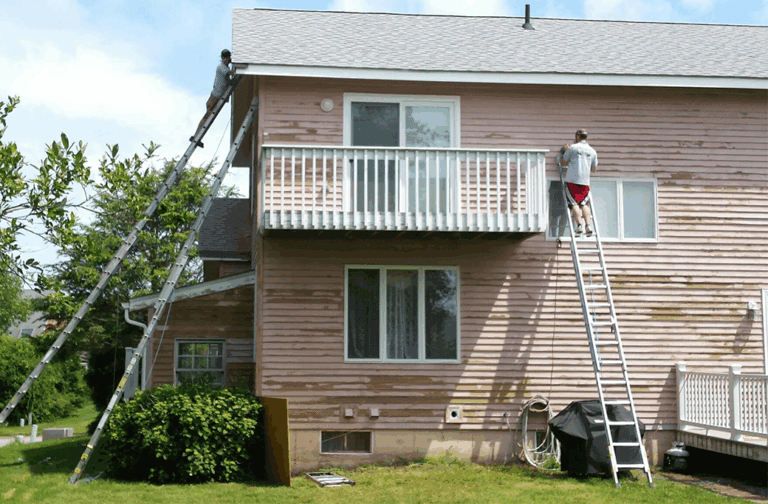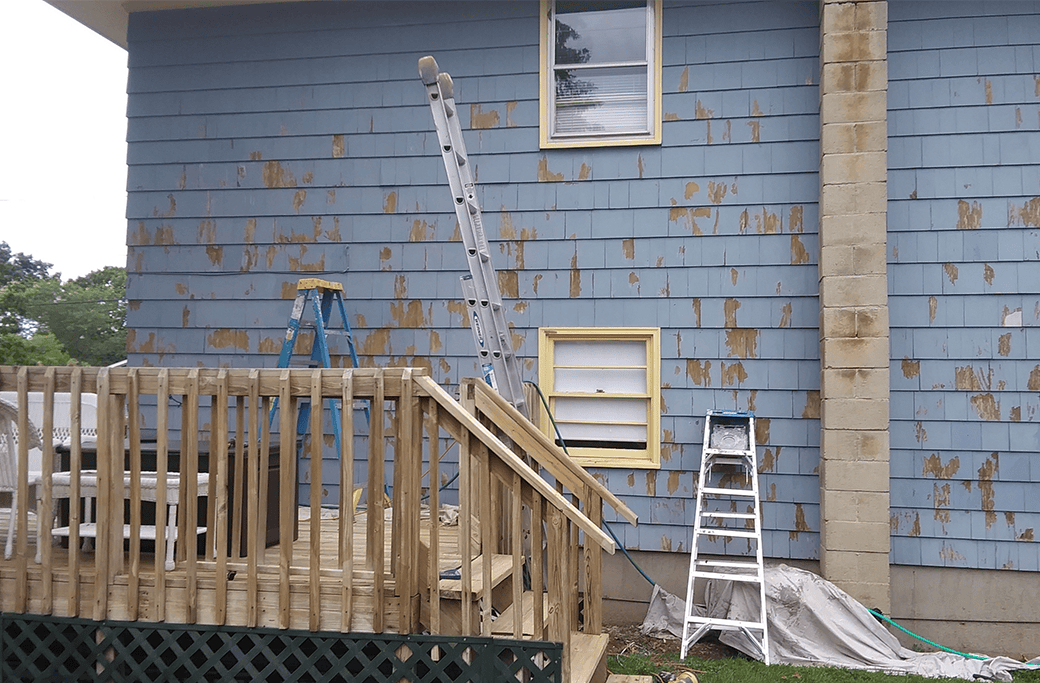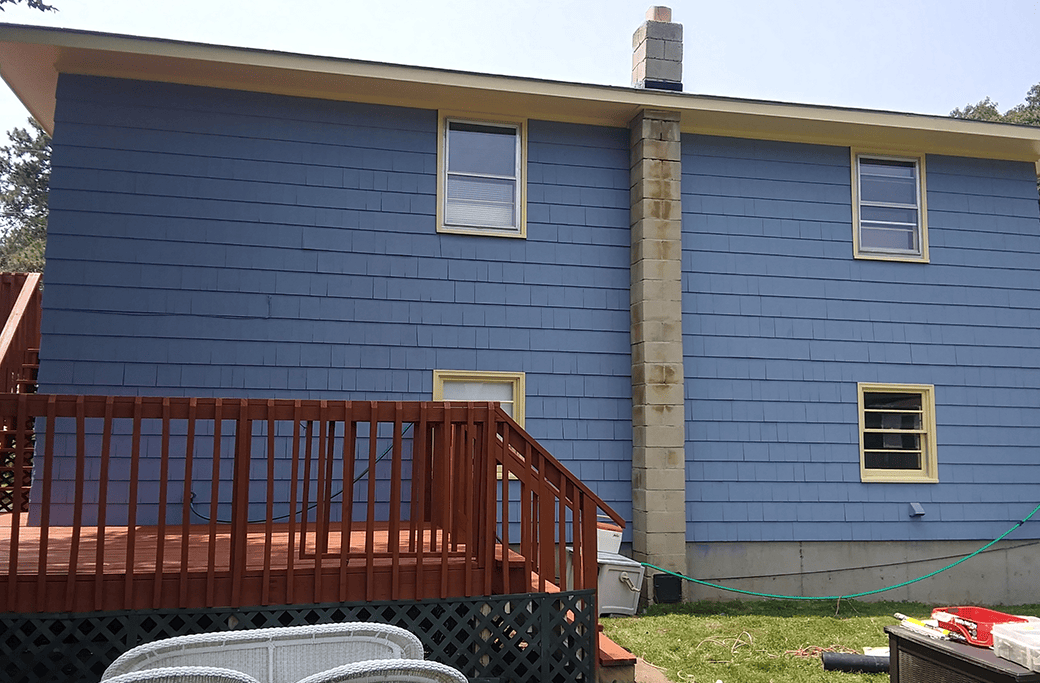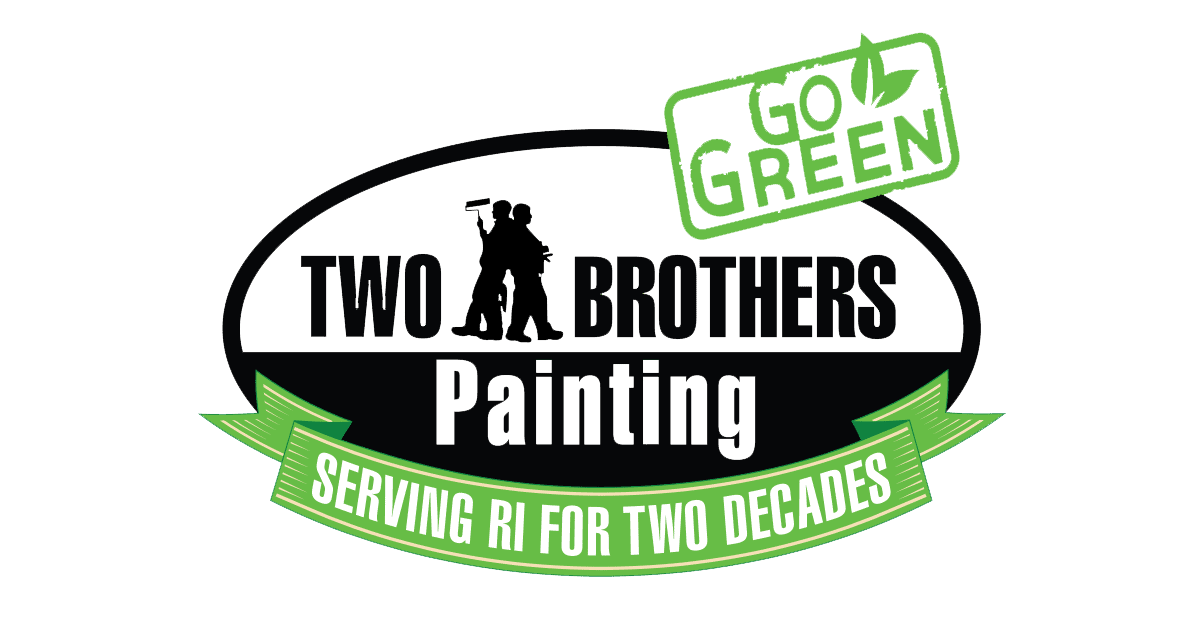
Your home’s exterior paint does more than create curb appeal—it’s your first line of defense against Rhode Island’s challenging coastal climate. From salt-laden ocean breezes to harsh winter storms, the Ocean State’s weather can take a serious toll on even the highest-quality paint jobs.
But how do you know when it’s time to refresh your home’s exterior? The answer depends on several factors, including your siding material, paint quality, and proximity to the coast. Understanding these variables can help you plan ahead and protect your investment.
General Guidelines for Exterior House Painting
The frequency of exterior house painting depends largely on your home’s siding material. Here’s what Rhode Island homeowners can typically expect:
Wood Siding: Every 5-7 Years
Wood requires the most frequent attention due to its porous nature. Natural wood expands and contracts with temperature changes, creating stress on paint films. High-quality paint and proper preparation can extend this timeline, but coastal homes may need repainting closer to the 5-year mark.
Aluminum Siding: Every 5-10 Years
Aluminum siding holds paint well, but chalking and fading are common issues. The metal surface can also show scratches and dings that compromise the protective coating. Regular maintenance and quality paint products can help you reach the 10-year mark.
Stucco: Every 6-10 Years
Stucco’s textured surface provides good paint adhesion, but cracks can develop over time, allowing moisture penetration. Proper sealing and high-grade paint can maximize longevity, especially when applied by experienced exterior painting Rhode Island professionals.
Painted Brick: Every 10-15 Years
Brick naturally resists weather damage, making it the longest-lasting option. However, once you paint brick, you’ll need to maintain it regularly. The key is using breathable masonry paint that allows moisture to escape.
Keep in mind that these are general guidelines. Rhode Island’s unique coastal conditions often accelerate paint deterioration, particularly for homes within a few miles of the ocean.
How Rhode Island’s Climate Affects Your Paint Job
Living in Rhode Island means your home faces a perfect storm of paint-damaging conditions. Understanding these challenges helps explain why coastal paint protection is so essential.
Coastal Humidity and Salt Air
The Ocean State’s humidity levels can remain high for extended periods, especially during summer months. This moisture can penetrate paint films, causing blistering and peeling. Salt particles carried by ocean breezes are particularly destructive, acting as tiny abrasives that break down paint molecules over time.
Freeze-Thaw Cycles
Rhode Island winters bring repeated freeze-thaw cycles that cause building materials to expand and contract. This movement stresses paint films, leading to cracking and separation. Ice dams and snow accumulation can also trap moisture against painted surfaces.
UV Exposure and Weather Extremes
Even in New England, UV rays fade paint colors and break down protective resins. Combined with driving rain from nor’easters and strong coastal winds, these conditions create a harsh environment for exterior finishes.
This is why working with local experts who understand Rhode Island’s climate is essential. At Two Brothers Painting, we’ve spent years perfecting techniques and selecting materials specifically for our coastal conditions.
Special Considerations for Coastal Properties

If your home sits within sight of the ocean, you’re dealing with the most challenging conditions for exterior paint. Salt air accelerates paint deterioration in several ways:
Accelerated Paint Breakdown
Salt particles act like microscopic sandpaper, gradually wearing away paint films. They also attract moisture, keeping painted surfaces damp longer than inland properties.
Corrosion and Staining
Metal components like gutters, downspouts, and trim can develop rust stains that bleed through paint. Salt exposure also causes chalking, where paint surfaces develop a powdery residue.
Frequent Maintenance Needs
Coastal homes often require house repainting RI services every 3-5 years instead of the typical 5-7 year cycle. Regular washing and touch-ups between paint jobs can help extend the life of your exterior finish.
Specialized Paint Products
Standard exterior paints aren’t designed for salt air exposure. Marine-grade or elastomeric coatings provide superior protection but require professional application. These high-performance products resist salt damage, UV fading, and moisture penetration.
Clear Signs It’s Time to Repaint
Don’t wait for complete paint failure. Catching problems early can save you money and prevent damage to your home’s exterior. Watch for these warning signs:
Color Changes
Fading is often the first sign that your paint is losing its protective properties. Chalking—a powdery residue on the surface—indicates that the paint binder is breaking down.
Paint Film Failure
Peeling, bubbling, or cracking paint has lost its ability to protect your siding. These problems typically start in high-wear areas like trim and gradually spread if left untreated.
Exposed Substrate
Any areas where bare wood, metal, or other materials show through need immediate attention. Exposed surfaces can suffer permanent damage from moisture and UV exposure.
Biological Growth
Mold, mildew, or algae growth often indicates trapped moisture—a sign that your paint barrier has been compromised. These growths can also cause permanent staining if not addressed promptly.
Making Your Paint Job Last Longer

Proper preparation and quality materials are your best defense against Rhode Island’s challenging climate. Here’s how to maximize your investment:
Professional Preparation
Thorough surface preparation is vital for paint adhesion and longevity. This includes pressure washing, scraping loose paint, filling cracks, and applying appropriate primers. Cutting corners on prep work inevitably leads to premature paint failure.
Quality Paint Selection
Premium paints cost more upfront but provide better protection and longer service life. Look for products specifically designed for coastal conditions, with high levels of UV protection and moisture resistance.
Regular Maintenance
Annual washing removes salt deposits and biological growth that can damage paint films. Prompt attention to small problems prevents them from becoming major issues.
Strategic Touch-ups
Addressing minor problems immediately can extend the time between full repaints. Keep leftover paint for touch-ups, and don’t hesitate to address problem areas as they develop.
Why Choose Two Brothers Painting for Your Project

Rhode Island homeowners need contractors who understand local conditions and have the experience to deliver lasting results. Here’s what sets us apart:
Local Expertise
We’ve been serving Rhode Island communities for years, and we understand the unique challenges coastal properties face. Our team knows which materials work best in our climate and how to apply them for maximum durability.
Premium Materials and Methods
We use only high-quality, weather-resistant paints and primers designed for coastal conditions. Our preparation process ensures proper adhesion and long-term protection.
Proven Track Record
Rhode Island homeowners trust us for quality workmanship and reliable service. We’re fully licensed and insured, and we back our work with a comprehensive warranty.
Comprehensive Services
From minor touch-ups to complete exterior makeovers, we handle projects of all sizes. Our team can also address carpentry repairs and other issues that affect paint performance.
Best Timing for Exterior Painting in Rhode Island
Timing your painting project correctly can significantly impact the results. Rhode Island’s climate offers a relatively short window for optimal painting conditions.
Ideal Seasons
Late spring through early fall provides the best weather for exterior painting. Look for periods with mild temperatures (50-85°F), low humidity, and minimal precipitation.
Planning Ahead
Peak painting season fills up quickly, so book your project early. Many contractors, including Two Brothers Painting, offer scheduling advantages for customers who plan ahead.
Weather Considerations
Avoid painting during periods of high humidity, extreme temperatures, or when rain is forecast. Quality contractors will reschedule if conditions aren’t suitable for optimal results.
How Often Should You Repaint Your Rhode Island Home’s Exterior?
A well-maintained exterior paint job protects your home’s structure while enhancing its appearance and value. Whether you’re dealing with fading coastal colors or preparing for Rhode Island’s next storm season, professional exterior painting services provide the expertise and materials needed for lasting results.
Regular maintenance, quality materials, and professional application are essential for success in our challenging climate. Don’t wait until paint failure compromises your home’s protection—plan ahead and work with experienced local professionals.
Ready to protect and beautify your Rhode Island home? Contact Two Brothers Painting today for a free estimate. Our team will assess your home’s specific needs and recommend the best approach for your situation and budget. Let us help you maintain your home’s beauty and protection with a paint job that stands up to everything Rhode Island weather can deliver.
Free Painting Estimate
Do not fill this form out if you’re a solicitor.

